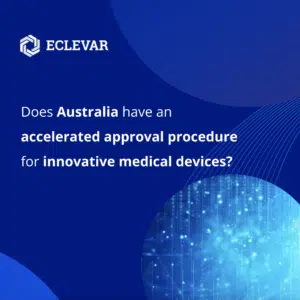Eclevar Australia provides an update on Australian regulatory pathway for breakthrough innovative medical devices – March 2023
The TGA priority review allows for accelerated access to breakthrough innovative medical devices, provided they meet eligibility criteria and have preliminary clinical trial data
New technologies, first-of-their-kind medical devices are usually developed before there are suitable regulations or standards to assess their safety and performance. Waiting until the slow cycle of regulatory renewal takes place only delays patient’ access to potentially lifesaving or life-improving products.
Following the recommendations of an independent review of therapeutic goods regulations in 2015, the TGA has introduced a priority review pathway for novel medical devices. Such priority or accelerated review pathways for emerging technologies already exist in the U.S. and China.
In the U.S. this is called the Breakthrough Devices Program; its goal is to provide patients and health care providers faster access to medical devices offering more effective treatment or diagnosis of life-threatening or irreversibly debilitating diseases or conditions. This program allows speeding up the development, assessment, and review of such new technologies, while preserving the statutory standards for premarket approval.
It is important to understand that the priority review pathway involves the same level of pre-market regulatory scrutiny, and that it is not intended for incremental improvements of existing devices. The eligibility criteria for the TGA priority review are very similar to those of the U.S. FDA Breakthrough Devices Program; the device must:
- be intended for the prevention, diagnosis, or treatment of a life-threatening or seriously debilitating condition
- address an unmet clinical need in Australian patients,
- represent a breakthrough technology, or offer a major clinical advantage over existing alternatives,
- for IVDs, the device must offer a major public health benefit to qualify for priority review.
A more detailed explanation of applying the eligibility criteria is provided in the TGA Guidance Priority applicant guidelines for medical devices (including IVDs) of December 2020.
Applications determined by the TGA to meet the eligibility criteria for a priority review pathway are placed at the front of the queue, with a dedicated coordinating assessor that supervises timely assessment and assignment of suitable review experts.
The TGA distinguishes two types of priority applicant determinations:
- Conformity assessment (priority applicant) determination – this is relevant if the applicant wishes to have a TGA-issued conformity assessment certificate as basis for ARTG inclusion. There is no need to apply for a separate medical devices (priority applicant) determination seeking priority consideration.
- Medical devices (priority applicant) determination – should be used if the applicant already has an overseas conformity assessment, and only needs to seek priority consideration in the ARTG inclusion process.
It is recommended to have a pre-submission meeting with the TGA to get some advice on the strength of the proposed application, and what to include in the application for a priority applicant determination. The advice provided during a pre-submission meeting is not binding, and companies should expect any guarantee to be provided during the meeting.
The application for priority review must include a document that addresses the eligibility criteria plus supporting information consisting of summaries (max 20 pages) of:
- relevant background discussion and data
- clinical investigations (summaries of study reports or resultant peer reviewed articles) providing support with reference to the relevant criteria
- other important safety and performance data obtained in the preclinical and/or clinical setting.
When submitting clinical trial data, it is important to ensure that the clinical trial was designed and conducted according to the latest version of ISO 14155 Clinical investigation of medical devices for human subjects — Good clinical practice. Additional considerations for clinical trial data:
- the version (configuration build) of the investigational devices used for clinical trials must be similar/ substantially equivalent to the version being submitted for priority review
- the patient cohort should be relevant to Australian population, especially if the clinical trial was conducted overseas
- the trial must be conducted in accordance with ethical practices defined in The National Statement on Ethical Conduct in Human Research 2007 (updated 2018) (National Statement)
It is very tempting to spread the news far and wide a new, promising technologies pass the proof-of-concept stage. However, innovators must be aware that advertising of unapproved therapeutic goods is illegal in Australia [ref Therapeutic Goods Act 1989 section 42DL (1)].
Manufacturers and/or sponsors of clinical trials aimed at establishing safety and performance of unapproved therapeutic goods are not allowed to advertise those products. They are however allowed to promote the clinical trial itself to encourage patient enrollment, but without specifically mentioning the name of the therapeutic good being used in the trial.
Any advertisement for a clinical trial should be approved by the ethics committee reviewing the trial as specified under section 5.2.23 of the National Statement and section 4.4.1 of the ICH Guideline for Good Clinical Practice.
For therapeutic goods included in the ARTG, advertising must be consistent with the information included in the ARTG entry, and consistent with the indication or the intended purpose of the therapeutic good. When advertising an approved therapeutic good, manufacturers and sponsors must comply with all applicable requirements of the Advertising Code of 2021.

